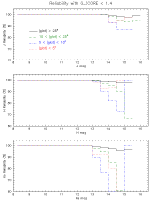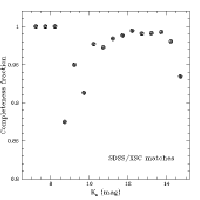 at J, H, and Ks, respectively) to
define the faint end of the lowest bin in each waveband.
at J, H, and Ks, respectively) to
define the faint end of the lowest bin in each waveband.
The Level 1 Specifications call for 99% reliability at galactic
latitude > 20° from the Galactic plane, and 80% reliability between 10°
and 20°. The specification indicates that completeness and reliability be
calculated "per magnitude in the faintest magnitude bin." 2MASS has used the
Level 1 sensitivity specification (15.0, 14.3, and 13.5 mag for
10- at J, H, and Ks, respectively) to
define the faint end of the lowest bin in each waveband.
at J, H, and Ks, respectively) to
define the faint end of the lowest bin in each waveband.
The XSC consists of two subsets, Extended Sources and Galaxies. Each candidate source was given a numeric flag, rating how extended it was and how galaxy-like it was, and sources passing a given threshold on either parameter were placed in the Catalog.
Because the goal of the XSC was to produce a reliable galaxy catalog, the Level 1 Specifications were interpreted as the galaxy reliability of the sources that exceeded the threshold for the galaxy flag. This is much more stringent than simply requiring that a source be extended. Double stars below the resolution of 2MASS are correctly picked up as extended sources, but they count as false sources for the galaxy reliability, since they are not galaxies.
Reliability is usually the hardest specification to measure, primarily due to the large variations in conditions encountered in an all-sky catalog. That is, one can analyze a subset of the data to determine its reliability, but this gives no assurance that different reliability problems do not occur elsewhere.
However, nearly one-third of the entire 2MASS XSC has been reviewed source by source by eye (see IV.5c1), with each source verified against its 2MASS image and an optical DSS image, when available. As far as we know, this produces the best reliability determination for any such large catalog at the time of the Release.
For bright sources, this reliability determination is definitive, and the entire set of sources in the XSC is virtually 100% reliable, with only a few false sources, due to missed artifacts. However, for fainter sources, a few percent of the sources cannot be definitively classified as galaxies, double stars, or misclassified single stars. Fortunately, a statistical analysis of these sources has found that at least 85% of them are most likely true galaxies. We use that minimum estimate of 85% to calculate our best estimate of the reliability below.
The reliability from visual inspection, for all sources with g_score < 1.4 (i.e., the ones that passed the "galaxy" threshold) with |b| > 25°, is as follows:
| Band | N_gal | N_not_gal | N_unk | Rel_min | Rel_max | Rel_est |
|---|---|---|---|---|---|---|
| J | 59,999 | 19 | 1919 | 96.9% | 100.0% | 99.5% |
| H | 94,284 | 212 | 2696 | 97.0% | 99.8% | 99.4% |
| K | 93,030 | 259 | 3589 | 96.0% | 99.7% | 99.2% |
As can be seen, it is quite likely that the XSC exceeds the stringent Level 1 specifications for galaxy reliability for |b| > 20°.
Figure 1 shows the reliability vs. magnitude, ignoring the unknowns.

|
| Figure 1 |
In addition, S. Van Dyk has compared all sources with g_score = 1 against the SDSS EDR, finding a reliability ~99% at the Level 1 specifications. This comparison is shown in Figure 2.

|
| Figure 2 |
(The dip in the 2MASS/SDSS match rate at 8.5 to 11 mag is apparently a feature in the SDSS. The unmatched XSC sources in this range are without question galaxies, with NED counterparts, and often with spiral structure visible in the 2MASS Atlas Images. In particular, T. Jarrett has looked at every single XSC source brighter than Ks = 12 mag, and nearly every one of them is clearly a galaxy. The reliability of this set from the visual analysis is 100.0%, to one decimal place, as shown in Figure 2.)
For galactic latitudes between 10 and 20°, we significantly exceed the Level 1 specification. From the visual inspection, the reliability is well above 90% in the appropriate magnitude bins, as shown in the first plot above.
A number of other tests have been performed, including:
All of these analyses verify the high reliability of the XSC.
An analysis of the calibration field repeats was done, but the number of galaxies in the field was too small to demonstrate anything, other than consistency with the above analyses.
For more information, see I. Extended Sources: 1. XSC Reliability.
[Last Updated: 2003 Jan 31; by T. Jarrett and T. Chester]